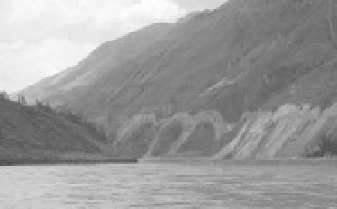Environmental Engineering Reference
In-Depth Information
Fig. 5.5
Sketch of vortices evolving due to velocity gradient (after Qian and Wan, 1983)
Subcritical and supercritical flows—
In open channel flow, the gravitational force is important. The
ratio of the inertial force to the gravitational force is the Froude number. The weight of water in a unit
volume is
J U
.
Then the Froude number is given by
g
FeU gh
/
(5.6)
in which
h
is the average depth of the river flow and
g
is the acceleration due to gravity.
If the Froude number is larger than 1, an open channel flow is supercritical. In a supercritical flow any
surface wave cannot propagate upstream and standing waves appear on the water surface. The water
depth is determined by discharge and local bed resistance, and is not affected by downstream conditions.
On the contrary, an open channel flow is subcritical if the Froude number is smaller than 1. In a subcritical
flow surface waves may propagate upstream and no standing waves form on the water surface. The water
depth is affected by discharge, local bed resistance, and downstream conditions. Flows in small mountain
streams are generally supercritical and flows in large rivers are subcritical. The middle and lower reaches
of large rivers are alluvial rivers with large discharge and low gradient, in which the flow is subcritical.
Figure 5.6(a) shows supercritical flow in a mountain stream and the standing waves, and Fig. 5.6(b) shows
subcritical flow in the Jinsha River, in which waves generated by a navigating boat are moving on the
water surface.
(a) (b)
Fig. 5.6
(a) Supercritical flow in a mountain stream, in which there are some standing waves; (b) Subcritical flow
in the Jinsha River, in which waves generated by a navigating boat are moving on the water surface (See color figure
at the end of this topic)





Search WWH ::

Custom Search